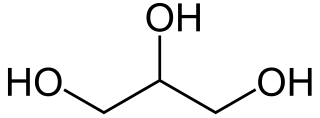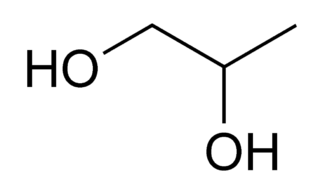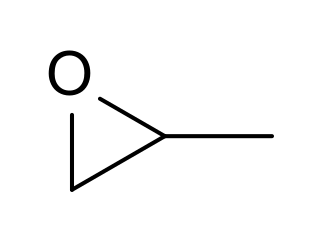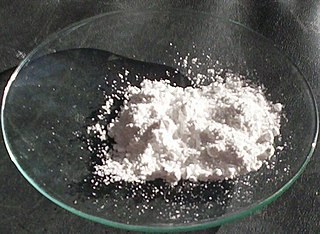
Ethylene glycol (IUPAC name: ethane-1,2-diol) is an organic compound with the formula (CH2OH)2. It is mainly used for two purposes, as a raw material in the manufacture of polyester fibers and for antifreeze formulations. It is an odorless, colorless, sweet-tasting, viscous liquid. Ethylene glycol is toxic. Household pets are especially susceptible to ethylene glycol poisoning from vehicle antifreeze leaks.

Glycerol is a simple polyol compound. It is a colorless, odorless, viscous liquid that is sweet-tasting and non-toxic. The glycerol backbone is found in many lipids which are known as glycerides. It is widely used in the food industry as a sweetener and humectant in pharmaceutical formulations. Glycerol has three hydroxyl groups that are responsible for its solubility in water and its hygroscopic nature.

Propylene glycol (IUPAC name: propane-1,2-diol) is a synthetic organic compound with the chemical formula C3H8O2. It is a viscous, colorless liquid which is nearly odorless but possesses a faintly sweet taste. Chemically it is classed as a diol and is miscible with a broad range of solvents, including water, acetone, and chloroform.

A tincture is typically an extract of plant or animal material dissolved in ethyl alcohol (ethanol). Solvent concentrations of 25–60% are common, but may run as high as 90%. In chemistry, a tincture is a solution that has ethanol as its solvent. In herbal medicine, alcoholic tinctures are made with various ethanol concentrations, 20% being the most common.

A marker pen, fineliner, marking pen, felt-tip marker, felt-tip pen, flow marker, texta, sketch pen or koki, is a pen which has its own ink source and a tip made of porous, pressed fibers such as felt. A permanent marker consists of a container and a core of an absorbent material. This filling serves as a carrier for the ink. The upper part of the marker contains the nib that was made in earlier time of a hard felt material, and a cap to prevent the marker from drying out. Until the early 1990s the most common solvents that were used for the ink were toluene and xylene. These two substances are both harmful and characterized by a very strong smell. Today, the ink is usually made on the basis of alcohols. Markers may be waterproof, dry-erase, wet-erase, or permanent.

A permanent marker or indelible marker is a type of marker pen that is used to create permanent or semi-permanent writing on an object. In general, the ink comprises a main carrier solvent, a glyceride, a pyrrolidone, a resin and a colorant, making it water resistant. It is capable of writing on a variety of surfaces from paper to metal to stone. They come in a variety of tip sizes, shapes, and colors. Like spray paint, these markers contain volatile organic compounds which evaporate to dry the ink. Due to compounds such as toluene and xylene often being present in permanent markers, they have a potential for abuse as a recreational drug.
A diol is a chemical compound containing two hydroxyl groups. An aliphatic diol is also called a glycol. This pairing of functional groups is pervasive, and many subcategories have been identified.

An antifreeze is an additive which lowers the freezing point of a water-based liquid and increases its boiling point.
An antifreeze mixture is used to achieve freezing-point depression for cold environments and also achieves boiling-point elevation ("anti-boil") to allow higher coolant temperature. Freezing and boiling points are colligative properties of a solution, which depend on the concentration of the dissolved substance.

Propylene oxide is an organic compound with the molecular formula CH3CHCH2O. This colourless volatile liquid with an odour resembling ether, is produced on a large scale industrially. Its major application is its use for the production of polyether polyols for use in making polyurethane plastics. It is a chiral epoxide, although it is commonly used as a racemic mixture.

A fog machine, fog generator, or smoke machine is a device that emits a dense vapor that appears similar to fog or smoke. This artificial fog is most commonly used in professional entertainment applications, but smaller, more affordable fog machines are becoming common for personal use. Fog machines can also be found in use in a variety of industrial, training, and some military applications. Typically, fog is created by vaporizing proprietary water and glycol-based or glycerin-based fluids or through the atomization of mineral oil. This fluid vaporizes or atomizes inside the fog machine. Upon exiting the fog machine and mixing with cooler outside air the vapor condenses, resulting in a thick visible fog.
Pharmaceutical glaze is an alcohol-based solution of various types of food-grade shellac. The shellac is derived from the raw material sticklac, which is a resin scraped from the branches of trees left from when the small insect, Kerria lacca, creates a hard, waterproof cocoon. When used in food and confections, it is also known as confectioner's glaze, resinous glaze, pure food glaze, natural glaze, or confectioner's resin.
Glycol ethers are a group of solvents based on alkyl ethers of ethylene glycol or propylene glycol commonly used in paints and cleaners. These solvents typically have a higher boiling point, together with the favorable solvent properties of lower-molecular weight ethers and alcohols. The word "Cellosolve" was registered in 1924 as a United States trademark by Carbide & Carbon Chemicals Corp. for "Solvents for Gums, Resins, Cellulose Esters, and the Like",; the first one was ethyl cellosolve, with the name now generic for glycol ethers.

Propylene carbonate (often abbreviated PC) is an organic compound with the formula C4H6O3. It is a cyclic carbonate ester derived from propylene glycol. This colorless and odorless liquid is useful as a polar, aprotic solvent. Propylene carbonate is chiral, but is used exclusively as the racemic mixture in most contexts.

Dimethyl carbonate (DMC) is an organic compound with the formula OC(OCH3)2. It is a colourless, flammable liquid. It is classified as a carbonate ester. This compound has found use as a methylating agent and more recently as a solvent that is exempt from the restrictions placed on most volatile organic compounds (VOCs) in the US. Dimethyl carbonate is often considered to be a green reagent.
A trap primer is a plumbing device or valve that adds water to traps. The water seals in traps are needed to prevent sewer gases from entering buildings, but because this water is exposed to the air, it is subject to evaporation over time in infrequently used floor drains, leading to the release of sewer gas into the environment. The trap primer mitigates this problem by injecting water, either directly or indirectly, into the trap to maintain the water seal indefinitely.
Tattoo inks consist of pigments combined with a carrier, and are used in tattooing.
Commodity chemicals are a group of chemicals that are made on a very large scale to satisfy global markets. The average prices of commodity chemicals are regularly published in the chemical trade magazines and web sites such as Chemical Week and ICIS. There have been several studies of the scale and complexity of this market for example in the USA.

Extraction in chemistry is a separation process consisting in the separation of a substance from a matrix. It includes Liquid-liquid extraction, and Solid phase extraction. The distribution of a solute between two phases is an equilibrium condition described by partition theory. This is based on exactly how the analyte move from the water into an organic layer.

Tavaborole is a topical antifungal medication for the treatment of onychomycosis, a fungal infection of the nail and nail bed. Tavaborole began its Phase 3 trials in December 2010 and was approved by the US FDA in July 2014. Tavaborole inhibits an essential fungal enzyme, leucyl-tRNA synthetase, that is required for protein synthesis. The inhibition of protein synthesis leads to termination of cell growth and then cell death, eliminating the fungal infection.
Chalkboard paint is a specialized paint that creates a chalkboard like coating that can be utilized as a writing surface in the same manner as a traditional chalkboard or blackboard. Chalkboard paint is commonly made out of a mixture of talc, acrylic, water, glycol, titanium dioxide, carbon black, opacifiers, silica, and esters. It may also contain acetone, propane, butane, xylene, ethylbenzene, amorphous silica, n-butyl acetate, and propylene glycol methyl ether acetate which are industrial standard ingredients used in inks and paints as thinners, olfactory, and pigmentation agents.
















